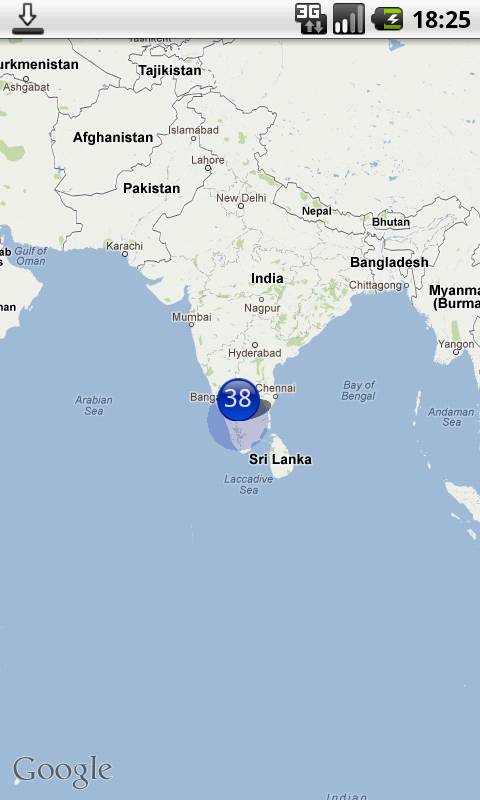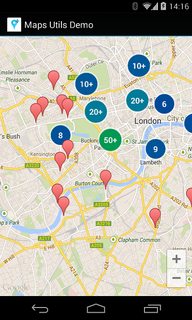Android Maps Point Clustering
y a-t-il un code pour le point Clustering dans android? Comment puis-je charger thousand pinpoint sans avoir des problèmes de performance?
7 réponses
la nuit dernière, je suis entré dans PointClustering sur Android MapView. Vu qu'il n'y avait rien pour la communauté, alors que je voudrais partager.
regroupe les géopoints si leur projection dans le mapView est trop proche. Ne rend aussi que les points visibles.
mise à JOUR
Code retravaillé de scrach.
maintenant disponible à GitHub
- Code retravaillé
- a utilisé l'algorithme de groupement GVM (assez rapide mais ne positionne pas le point groupé aussi bon que le mien)
- bientôt pour ajouter l'algorithme de groupement précédent aussi

j'ai retravaillé le code ci-dessus et j'ai contrôlé le no de l'icône de superposition dans la vue de carte et séparé le groupe et le point unique.
Mon Code:
MMapView.java
import java.util.ArrayList;
import java.util.List;
import android.content.Context;
import android.graphics.BitmapFactory;
import android.graphics.Canvas;
import android.graphics.drawable.BitmapDrawable;
import android.graphics.drawable.Drawable;
import android.util.AttributeSet;
import com.google.android.maps.GeoPoint;
import com.google.android.maps.MapView;
import com.google.android.maps.Overlay;
import com.impiger.maphighlight.R;
//Reference - /q/android-maps-point-clustering-30010/"title "+i, "snippet");
// Here is where the magic happens
addOverlayItemClustered(overlayitem, this,
geoPoints.size());
i++;
}
for(int j=0;j<mOverlays.size();j++){
OverlayItemExtended overlayItem = mOverlays.get(j);
if(overlayItem.isMaster){
if(overlayItem.slaves.size() > 0){
itemizedOverlay = new PMapViewOverlay(drawable, context);
itemizedOverlay.addOverlayItem(overlayItem);
}else{
itemizedOverlay = new PMapViewOverlay(emptyDrawable, context);
itemizedOverlay.addOverlayItem(overlayItem);
}
mapOverlays.add(itemizedOverlay);
}
}
}
/*
* Update the points at panned / zoom etc
*/
public void dispatchDraw(Canvas canvas) {
super.dispatchDraw(canvas);
if (getZoomLevel() != oldZoomLevel) {
placeOverlays();
}
oldZoomLevel = getZoomLevel();
}
public void addOverlayItemClustered(OverlayItemExtended thisOverlay,
MapView mapView, int totalPoints) {
for (OverlayItemExtended otherOverlay : mOverlays) {
/*
* Thresshold for the clustering
*/
/*
* Zoom level >15 don't cluster If less than Max_Visible_points
* don't cluster
*/
if (mapView.getZoomLevel() >= 14
|| (MAX_VISIBLE_POINTS > totalPoints)
&& PointCluster.getOverLayItemDistance(thisOverlay,
otherOverlay, mapView) > 60) {
mOverlays.add(thisOverlay);
return;
}
if (PointCluster.getOverLayItemDistance(thisOverlay, otherOverlay,
mapView) < 90 && !thisOverlay.isClustered) {
// Here is where the clustering actually happens
if (otherOverlay.isMaster) {
thisOverlay.isMaster = false;
// otherOverlay.isMaster = false;
thisOverlay.isClustered = true;
otherOverlay.isClustered = true;
otherOverlay.slaves.push(thisOverlay);
thisOverlay.parent = otherOverlay;
} else if (PointCluster.getOverLayItemDistance(thisOverlay,
otherOverlay.parent, mapView) < 90
&& otherOverlay.isClustered) {
thisOverlay.isMaster = false;
thisOverlay.isClustered = true;
thisOverlay.parent = otherOverlay.parent;
otherOverlay.parent.slaves.push(thisOverlay);
}
}
}
mOverlays.add(thisOverlay);
}
}
Overlayitemextend.java
import java.util.Stack;
import com.google.android.maps.GeoPoint;
import com.google.android.maps.OverlayItem;
public class OverlayItemExtended extends OverlayItem {
public boolean isClustered = false;
public boolean isMaster = true;
public boolean isMe = false;
public OverlayItemExtended parent;
public Stack<OverlayItemExtended> slaves = new Stack<OverlayItemExtended>();
public OverlayItemExtended(GeoPoint point, String title, String snippet) {
super(point, title, snippet);
}
}
PMapViewOverlay.java
import java.util.ArrayList;
import android.content.Context;
import android.graphics.Canvas;
import android.graphics.Color;
import android.graphics.Paint;
import android.graphics.Point;
import android.graphics.drawable.Drawable;
import android.widget.Toast;
import com.google.android.maps.GeoPoint;
import com.google.android.maps.ItemizedOverlay;
import com.google.android.maps.MapView;
@SuppressWarnings("rawtypes")
public class PMapViewOverlay extends ItemizedOverlay {
private static final String TAG = PMapViewOverlay.class.getSimpleName();
private Context context;
private ArrayList<OverlayItemExtended> mOverlays;
public PMapViewOverlay(Drawable defaultMarker, Context context) {
super(boundCenterBottom(defaultMarker));
this.context = context;
mOverlays = new ArrayList<OverlayItemExtended>();
paint.setTextAlign(Paint.Align.CENTER);
paint.setTextSize(25);
paint.setAntiAlias(true);
paint.setStrokeWidth(5);
paint.setColor(Color.WHITE);
}
@Override
protected OverlayItemExtended createItem(int i) {
return mOverlays.get(i);
}
@Override
public int size() {
return mOverlays.size();
}
public void addOverlayItem(OverlayItemExtended overlay) {
mOverlays.add(overlay);
populate();
}
public void removeAllOverlays() {
mOverlays.clear();
populate();
}
public void removePointsButMe() {
for (int i = 0; i < mOverlays.size(); i++) {
OverlayItemExtended overlay = mOverlays.get(i);
if (overlay.isMe) {
mOverlays.clear();
addOverlayItem(overlay);
break;
}
}
populate();
}
Paint paint = new Paint();
@Override
public void draw(Canvas canvas, MapView mapView, boolean shadow) {
super.draw(canvas, mapView, shadow);
// cycle through all overlays
for (int index = 0; index < mOverlays.size(); index++) {
OverlayItemExtended item = mOverlays.get(index);
// Converts lat/lng-Point to coordinates on the screen
GeoPoint point = item.getPoint();
Point ptScreenCoord = new Point();
mapView.getProjection().toPixels(point, ptScreenCoord);
if (item.isMaster) {
if (item.slaves.size() > 0) {
canvas.drawText(item.slaves.size() + 1 + "",
ptScreenCoord.x, ptScreenCoord.y - 13, paint);
}
}
}
}
@Override
protected boolean onTap(int index) {
OverlayItemExtended item = mOverlays.get(index);
if (item.isMaster) {
if (item.slaves.size() == 0) {
Toast.makeText(context, "You tapped item " + item.getTitle(),
Toast.LENGTH_LONG).show();
}
}
return super.onTap(index);
}
}
Je n'ai pas changé de code dans PointCluster.Java.
j'espère que cela aidera quelqu'un. 
, Il en est un bel exemple. Vérifiez ici: http://code.google.com/p/android-playground-erdao/source/browse/trunk/SampleClusterMap/?r=226
il y a une demande de pull sur github pour la bibliothèque Polaris (https://github.com/cyrilmottier/Polaris), qui ajoute le regroupement:
il y a aussi cette réponse qui exige seulement que vous outrepassiez la méthode de tirage de votre superposition. Il divise votre mapView en sections, donc il est un peu moins sophistiqué. Mais au moins, il a travaillé.
pour ANDROID V2 voici va CLUSTERING CODE
Salut À Tous
j'ai regardé diverses bibliothèques et les ai trouvées si complexes ne pouvaient pas comprendre un mot alors j'ai décidé de faire mon propre algo clutering Voici mon code en java
static int OFFSET = 268435456;
static double RADIUS = 85445659.4471;
static double pi = 3.1444;
public static double lonToX(double lon) {
return Math.round(OFFSET + RADIUS * lon * pi / 180);
}
public static double latToY(double lat) {
return Math.round(OFFSET
- RADIUS
* Math.log((1 + Math.sin(lat * pi / 180))
/ (1 - Math.sin(lat * pi / 180))) / 2);
}
public static int pixelDistance(double lat1, double lon1, double lat2,
double lon2, int zoom) {
double x1 = lonToX(lon1);
double y1 = latToY(lat1);
double x2 = lonToX(lon2);
double y2 = latToY(lat2);
return (int) (Math
.sqrt(Math.pow((x1 - x2), 2) + Math.pow((y1 - y2), 2))) >> (21 - zoom);
}
static ArrayList<Cluster> cluster(ArrayList<Marker> markers, int zoom) {
ArrayList<Cluster> clusterList = new ArrayList<Cluster>();
ArrayList<Marker> originalListCopy = new ArrayList<Marker>();
for (Marker marker : markers) {
originalListCopy.add(marker);
}
/* Loop until all markers have been compared. */
for (int i = 0; i < originalListCopy.size();) {
/* Compare against all markers which are left. */
ArrayList<Marker> markerList = new ArrayList<Marker>();
for (int j = i + 1; j < markers.size();) {
int pixelDistance = pixelDistance(markers.get(i).getLatitude(),
markers.get(i).getLongitude(), markers.get(j)
.getLatitude(), markers.get(j).getLongitude(),
zoom);
if (pixelDistance < 40) {
markerList.add(markers.get(i));
markerList.add(markers.get(j));
markers.remove(j);
originalListCopy.remove(j);
j = i + 1;
} else {
j++;
}
}
if (markerList.size() > 0) {
Cluster cluster = new Cluster(clusterList.size(), markerList,
markerList.size() + 1, originalListCopy.get(i)
.getLatitude(), originalListCopy.get(i)
.getLongitude());
clusterList.add(cluster);
originalListCopy.remove(i);
markers.remove(i);
i = 0;
} else {
i++;
}
/* If a marker has been added to cluster, add also the one */
/* we were comparing to and remove the original from array. */
}
return clusterList;
}
il suffit de passer dans votre liste de tableaux ici contenant la latitude et la longitude ensuite, pour afficher les grappes voici la fonction
@Override
public void onTaskCompleted(ArrayList<FlatDetails> flatDetailsList) {
LatLngBounds.Builder builder = new LatLngBounds.Builder();
originalListCopy = new ArrayList<FlatDetails>();
ArrayList<Marker> markersList = new ArrayList<Marker>();
for (FlatDetails detailList : flatDetailsList) {
markersList.add(new Marker(detailList.getLatitude(), detailList
.getLongitude(), detailList.getApartmentTypeString()));
originalListCopy.add(detailList);
builder.include(new LatLng(detailList.getLatitude(), detailList
.getLongitude()));
}
LatLngBounds bounds = builder.build();
int padding = 0; // offset from edges of the map in pixels
CameraUpdate cu = CameraUpdateFactory.newLatLngBounds(bounds, padding);
googleMap.moveCamera(cu);
ArrayList<Cluster> clusterList = Utils.cluster(markersList,
(int) googleMap.getCameraPosition().zoom);
// Removes all markers, overlays, and polylines from the map.
googleMap.clear();
// Zoom in, animating the camera.
googleMap.animateCamera(CameraUpdateFactory.zoomTo(previousZoomLevel),
2000, null);
CircleOptions circleOptions = new CircleOptions().center(point) //
// setcenter
.radius(3000) // set radius in meters
.fillColor(Color.TRANSPARENT) // default
.strokeColor(Color.BLUE).strokeWidth(5);
googleMap.addCircle(circleOptions);
for (Marker detail : markersList) {
if (detail.getBhkTypeString().equalsIgnoreCase("1 BHK")) {
googleMap.addMarker(new MarkerOptions()
.position(
new LatLng(detail.getLatitude(), detail
.getLongitude()))
.snippet(String.valueOf(""))
.title("Flat" + flatDetailsList.indexOf(detail))
.icon(BitmapDescriptorFactory
.fromResource(R.drawable.bhk1)));
} else if (detail.getBhkTypeString().equalsIgnoreCase("2 BHK")) {
googleMap.addMarker(new MarkerOptions()
.position(
new LatLng(detail.getLatitude(), detail
.getLongitude()))
.snippet(String.valueOf(""))
.title("Flat" + flatDetailsList.indexOf(detail))
.icon(BitmapDescriptorFactory
.fromResource(R.drawable.bhk_2)));
}
else if (detail.getBhkTypeString().equalsIgnoreCase("3 BHK")) {
googleMap.addMarker(new MarkerOptions()
.position(
new LatLng(detail.getLatitude(), detail
.getLongitude()))
.snippet(String.valueOf(""))
.title("Flat" + flatDetailsList.indexOf(detail))
.icon(BitmapDescriptorFactory
.fromResource(R.drawable.bhk_3)));
} else if (detail.getBhkTypeString().equalsIgnoreCase("2.5 BHK")) {
googleMap.addMarker(new MarkerOptions()
.position(
new LatLng(detail.getLatitude(), detail
.getLongitude()))
.snippet(String.valueOf(""))
.title("Flat" + flatDetailsList.indexOf(detail))
.icon(BitmapDescriptorFactory
.fromResource(R.drawable.bhk2)));
} else if (detail.getBhkTypeString().equalsIgnoreCase("4 BHK")) {
googleMap.addMarker(new MarkerOptions()
.position(
new LatLng(detail.getLatitude(), detail
.getLongitude()))
.snippet(String.valueOf(""))
.title("Flat" + flatDetailsList.indexOf(detail))
.icon(BitmapDescriptorFactory
.fromResource(R.drawable.bhk_4)));
} else if (detail.getBhkTypeString().equalsIgnoreCase("5 BHK")) {
googleMap.addMarker(new MarkerOptions()
.position(
new LatLng(detail.getLatitude(), detail
.getLongitude()))
.snippet(String.valueOf(""))
.title("Flat" + flatDetailsList.indexOf(detail))
.icon(BitmapDescriptorFactory
.fromResource(R.drawable.bhk5)));
} else if (detail.getBhkTypeString().equalsIgnoreCase("5+ BHK")) {
googleMap.addMarker(new MarkerOptions()
.position(
new LatLng(detail.getLatitude(), detail
.getLongitude()))
.snippet(String.valueOf(""))
.title("Flat" + flatDetailsList.indexOf(detail))
.icon(BitmapDescriptorFactory
.fromResource(R.drawable.bhk_5)));
}
else if (detail.getBhkTypeString().equalsIgnoreCase("2 BHK")) {
googleMap.addMarker(new MarkerOptions()
.position(
new LatLng(detail.getLatitude(), detail
.getLongitude()))
.snippet(String.valueOf(""))
.title("Flat" + flatDetailsList.indexOf(detail))
.icon(BitmapDescriptorFactory
.fromResource(R.drawable.bhk_2)));
}
}
for (Cluster cluster : clusterList) {
BitmapFactory.Options options = new BitmapFactory.Options();
options.inMutable = true;
options.inPurgeable = true;
Bitmap bitmap = BitmapFactory.decodeResource(getResources(),
R.drawable.cluster_marker, options);
Canvas canvas = new Canvas(bitmap);
Paint paint = new Paint();
paint.setColor(getResources().getColor(R.color.white));
paint.setTextSize(30);
canvas.drawText(String.valueOf(cluster.getMarkerList().size()), 10,
40, paint);
googleMap.addMarker(new MarkerOptions()
.position(
new LatLng(cluster.getClusterLatitude(), cluster
.getClusterLongitude()))
.snippet(String.valueOf(cluster.getMarkerList().size()))
.title("Cluster")
.icon(BitmapDescriptorFactory.fromBitmap(bitmap)));
}
}
TOUTE QUESTION OU DOUTE S'IL VOUS PLAÎT, DEMANDEZ À WILL DE LES BLANCHIR TOUS ...........Merci
Google Android Carte Utils a une solution pour cela: Google Maps Android Marqueur de Clustering Utilitaire .
ajouter dépendance
implementation 'com.google.maps.android:android-maps-utils:0.5'
Faites votre propre ClusterItem
class MyItem(
private val position: LatLng,
val title: String,
private val snippet: String
) : ClusterItem {
override fun getPosition() = position
override fun getTitle() = title
override fun getSnippet() = snippet
}
mise en place du cluster manager et ajout d'éléments
override fun onMapReady(googleMap: GoogleMap) {
val clusterManager = ClusterManager<MyItem>(this, googleMap)
googleMap.setOnCameraIdleListener(clusterManager)
clusterManager.addItem(MyItem(LatLng(51.51, -0.12), "title", "snippet"))
}
Ça y est! Les éléments sont maintenant affichés comme suit:
personnaliser l'icône
afin de personnaliser l'icône, Ajouter val icon: BitmapDescriptor à votre ClusterItem et changer le renderer du cluster manager:
clusterManager.renderer = object : DefaultClusterRenderer<MyItem>(this, googleMap, clusterManager) {
override fun onBeforeClusterItemRendered(item: MyItem, markerOptions: MarkerOptions) {
markerOptions.icon(item.icon)
}
}
à fabriquer des objets cliquables
en règle générale, toute l'interaction avec les marqueurs devrait plutôt passer par le gestionnaire de grappes. Il en va de même pour rendre les articles cliquables.
googleMap.setOnMarkerClickListener(clusterManager)
clusterManager.setOnClusterItemClickListener {
Toast.makeText(this, "Clicked on item ${it.title}", Toast.LENGTH_SHORT).show()
true
}
de même, vous pouvez appeler googleMap.setOnInfoWindowClickListener(clusterManager) et clusterManager.setOnClusterItemInfoWindowClickListener pour gérer les clics sur la fenêtre d'information.
